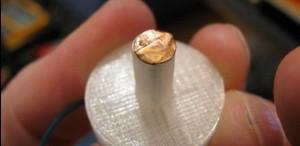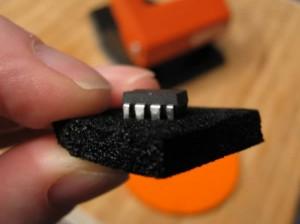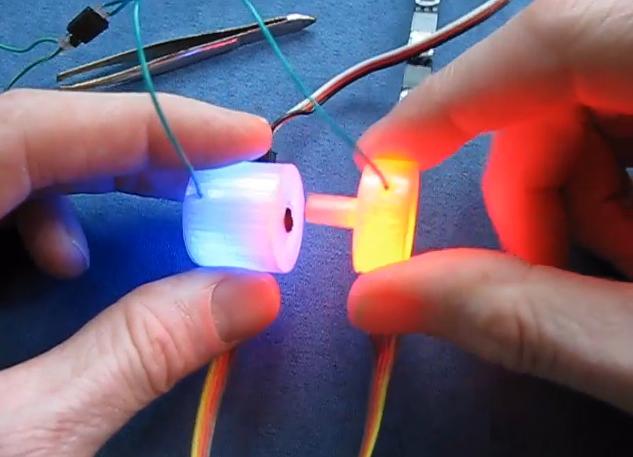Let’s Make Robots is a free, volunteer-based initiative started in 2008 and now entirely produced and maintained by members of their community, and they have lots of cool projects which rely heavily on 3D printing on the site.
Now Gareth, a very active member of the site, has done a demonstration of how to make a simple, 3D printed touch sensor with what’s called ‘conductive foam.’
Conductive foam is most often used to protect integrated circuits from static electricity and it’s generally found wrapped around the circuits for shipping, but it’s not just shipping material; it has some very interesting resistance properties.
 Conductive foam acts as a resistor, but not only a resistor, it can also be a ‘variable resistor’ – or a resistor whose value depends on how much it is being compressed.
Conductive foam acts as a resistor, but not only a resistor, it can also be a ‘variable resistor’ – or a resistor whose value depends on how much it is being compressed.
Gareth’s project takes advantage of the foam’s property to create an accurate – and repeatable – pressure sensor switching system.
The project uses two 3D printed parts as the body of the pressure sensor unit, and the pair of contacts are placed at either end. Small copper strips are sandwiched around the conductive foam to create a displacement resistance version of a touch sensor.
 The sensor can be hooked – via an analogue input – to any of the common MCU chips like the Parallax Propeller, Arduino, Picaxe, or Raspberry Pi. Gareth used CAT5 Ethernet inner wires soldered onto each of the copper disks, fed the wiring into the 3D printed base and plunger, and after some tweaking to get just the right degree of ‘touchiness’ or resistance value, voilà!
The sensor can be hooked – via an analogue input – to any of the common MCU chips like the Parallax Propeller, Arduino, Picaxe, or Raspberry Pi. Gareth used CAT5 Ethernet inner wires soldered onto each of the copper disks, fed the wiring into the 3D printed base and plunger, and after some tweaking to get just the right degree of ‘touchiness’ or resistance value, voilà!
 The two 3D printed parts are made to move inside each other like a hydraulic ram to compress the conductive foam in between them, and Gareth says you can make it happen even if you don’t have a 3D printer. He says the system could be replicated with a straw and toothpick.
The two 3D printed parts are made to move inside each other like a hydraulic ram to compress the conductive foam in between them, and Gareth says you can make it happen even if you don’t have a 3D printer. He says the system could be replicated with a straw and toothpick.
You can download the 3D printable files from Thingiverse. You can see Gareth’s other projects here or a whole bunch of excellent demonstrations on his YouTube page.
3D printing and readily available materials are being used by makers every day to create novel and inexpensive devices. What do you think of this pressure sensitive switch made from conductive foam by Gareth of Let’s Make Robots? Have you ever used 3D printing to make an electronic device? Please weigh in with your opinion or show us something you’ve made with 3D printing on the Conductive Foam and 3D Printing forum thread on 3DPB.com.
Subscribe to Our Email Newsletter
Stay up-to-date on all the latest news from the 3D printing industry and receive information and offers from third party vendors.
You May Also Like
Gorilla Sports GE’s First 3D Printed Titanium Cast
How do you help a gorilla with a broken arm? Sounds like the start of a bad joke a zookeeper might tell, but it’s an actual dilemma recently faced by...
Nylon 3D Printed Parts Made More Functional with Coatings & Colors
Parts 3D printed from polyamide (PA, Nylon) 12 using powder bed fusion (PBF) are a mainstay in the additive manufacturing (AM) industry. While post-finishing processes have improved the porosity of...
$25M to Back Sintavia’s Largest Expansion of Metal 3D Printing Capacity Since 2019
Sintavia, the digital manufacturing company specializing in mission-critical parts for strategic sectors, announced a $25 million investment to increase its production capacity, the largest expansion to its operations since 2019....
Velo3D Initiates Public Offering in a Bid to Strengthen Financial Foundations and Drive Future Growth
Velo3D (NYSE: VLD) has been among a number of publicly traded 3D printing firms that have attempted to weather the current macroeconomic climate. After posting a challenging financial report for 2023,...
































